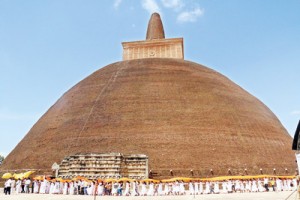Abhayagiri towers once again
Abhayagiri Sthupa towers once again in dignified splendour with the unveiling by President Maithripala Sirisena on the completion of its restoration.The ceremony was conducted on Esala Full Moon Poya Day amidst thousands of devotees who arrived in Anuradhapura to participate in this special event. The twenty-year restoration was undertaken by the Central Cultural Fund which was responsible for the conservation of the Abhayagiri Complex.

Dignified splendour: Unveiling ceremony of the Abhayagiri Stupa. Pic by Athula Bandara
Abhayagiri was a marvel when it was built in the second century BC as it was the tallest construction rising over 75 metres and 106.6 metres in diameter at the widest point of the curve. The Monastery-complex built on five hundred acres remained the biggest monastic centre for six hundred years making it home for five thousand monks. Fa-hsieng – the Chinese monk who stayed at the Monastery for two years when he visited Sri Lanka in 412 AD was amazed to find such opulence in the vihara (“The magnificence defied description.”)And Abhayagiri was the choice to house the Buddha’s Tooth Relic brought to Sri Lanka during the reign of Kithsirimevan (303-331AD.)
Feats and the importance attached to the Sthupa apart, Abhayagiri offers a fine insight into a period when politics impacted on the religion and the inter-religious turmoil that existed in early Lankan history. VattagamaniAbhaya or Valagambha, the builder of Abhayagiri inherited a peaceful country, but five months into his reign, in 103 BC, a Brahmin revolted against him and five South Indian invaders arrived and usurped the throne. The King took flight and when Giri, a priest of the Jain Monastery saw the King fleeing he shouted “the great black Sinhalaya is fleeing,” an action the King noted.
Valagambha went into exile, collected troops and fourteen years later returned and defeated the last usurper. Thus he started his second period of reign (89-77BC) and one of his first acts was to build Abhayagiri on the site of the Jain Monastery where its priest Giri jeered at him while he was fleeing.The Monastery had been built by King Pandukabhaya for the Jains in the Northern Gate of the Anuradhapura City. Valagambha razed it to the ground and thereafter appointed Mahatissa Thera – a monk who supported him while he was in exile as its chief incumbent – an act which set off repercussions that lasted for several centuries. And coining his name Abhaya with Giri – the name of the Jain who jeered, he named the monument Abhayagiri.
Up till Valagambha’s reign, Mahavihara was the custodian of the orthodox Theravada Doctrine – the only Doctrine that existed in Sri Lanka since Buddhism was introduced. With the Mahavihara having the authority to take decisions in the practice of the Doctrine, it opposed the appointment of Mahatissa Thera as the Chief Incumbant of the Abhayagiri. The King made the ruling without consulting Mahavihara. The decision led the Abhayagiri to become the seat of dissident monks. Thus commenced rivalry between the two Viharas and Abhayagiri developed into a parallel Buddhist institution.
BothViharas however, practised the Theravada Doctrine until a monk by the name of Dhammaruchi from the Vajjiputtaka sect arrived in 77BC. He arrived from India at the Abhayagiri Monastery and won over Abhayagiri monks to his sect. The new sect broke away from the Theravada Teachings. In the third century AD, another attempt was made to introduce Vaitulyavadato Abhayagiri monks – a corrupt school of thought, which was, however suppressed.
The battle raged for six centuries and one of the worst periods suffered by Mahavihara was during the reign of Mahasen in the third century AD. He harassed its monks, prohibited the giving of alms to the Mahavihara, even demolished Mahavihara buildings and used the material in the construction of Abhayagiri buildings. And Abhayagiri by this time had developed as a leading Buddhist centre which professed the Mahayana Doctrine growing into an international centre of the Arts, Philosophy and Mysticism with branches set up in Java, China and Burma.
There however is very little literary evidence available on Abhayagiri in the chronicles as the rival monks of the Mahavihara were its compilers. The chronicle of Abhayagiri – “Uttara Vamsa” compiled by the monks of Abhayagiri or the Northern Monastery (Uttararamaya) in the meantime, is lost. If it is found we have the opportunity to learn more about Abhayagiri.
Fortunes changed for Mahavihara with the accession of Gothabhaya (253-266AD.) He remodelled Mahavihara buildings and renovated dilapidated monastic residences throughout the island. When Mahayanism reappeared and Abhayagiri received it, Gothabhaya rebuked the sixty monks who brought and spread it banishing them to India.
In a move to avenge this action,a monk named Sanghamitta arrived from India and got himself appointed as tutor to Gothabhaya’s sons. He won over Mahasen and when he began his reign,Sanghamitta got him to make a Royal Decree forbidding Royal charity to the Mahavihara.Mahavihara bereft of assistance closed down the Vihara for nine years when it was torn down.
Eventually, Sanghamitta fell out of Mahasen’s favour.But, yet another won the king’s favours and got the King to carve out part of the Mahavihara premises to build a monastery for him. Agreeing to the request Mahasen built the JetavanaVihara – Lanka’s largest and the tallest Sthupa, thus making it the third monastic system rivalling Mahavihara and Abhayagiri.


